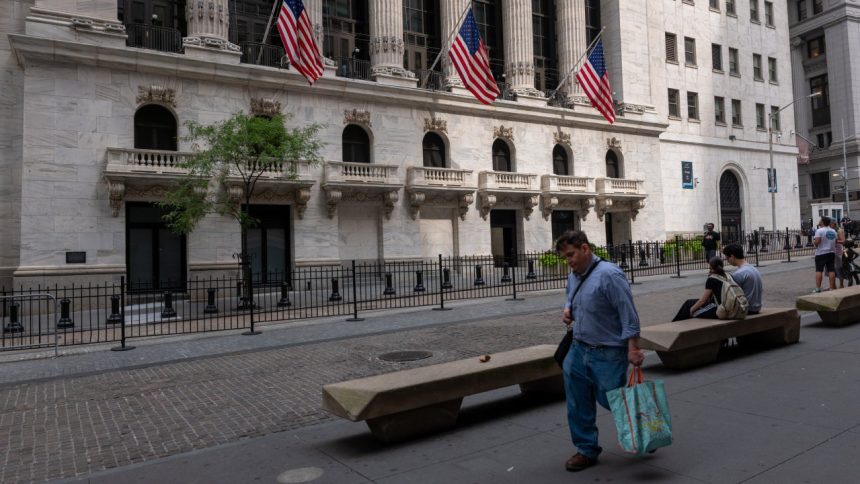Spencer Platt/Getty Images
The NYSE Composite Index tracks more than 2,000 stocks listed on the New York Stock Exchange (NYSE) and includes foreign and tracking stocks, real estate investment trusts and American Depositary Receipts (ADRs), providing a broad overview of market performance for investors.
Think of the index like a playlist of the greatest hits across multiple genres, countries and artists, offering a mix of investments instead of a studio album by one artist.
Here’s a rundown of how the NYSE Composite Index works, how it’s weighted and how to invest in it.
How the NYSE Composite works
The NYSE Composite Index (NYA) was created in 1966 to reflect all the common stocks traded within the NYSE and tracks four main areas including the utility, industrial, financial and transportation sectors. Because the index is comprehensive and includes high-quality companies, many investors use it to gauge how the economy and markets are performing.
These diverse components help investors with that bigger picture.
- Foreign stocks: More than 300 global, non-U.S. companies appear on the NYSE Composite Index.
- Tracking stocks: Issued by companies, tracking stocks follow the financial performance of a segment within a company, allowing investors to focus on that business unit.
- American Depositary Receipts: ADRs are equity securities that allow a global company to be traded on major U.S. exchanges, such as the NYSE. Toyota, for example, uses ADRs to trade in the U.S.
- Real estate investment trust: A REIT is a company that owns, manages or finances real estate and pays income to investors who gain exposure to that market without owning property.
The NYSE Composite includes dozens of household names, such as these popular stocks listed as of July 2024.
| American Express (AXP) | Dollar General (DG) | JPMorgan Chase (JPM) |
| AT&T (T) | Exxon Mobil (XOM) | Morgan Stanley (MS) |
| Bank of America (BAC) | FedEx (FDX) | Nike (NKE) |
| Best Buy (BBY) | Ford Motor Co (F) | Pfizer (PFE) |
| Boeing (BA) | General Mills (GIS) | Procter & Gamble (PG) |
| CAVA Group (CAVA) | General Motors (GM) | Target (TGT) |
| Chevron (CVX) | Goldman Sachs (GS) | Toyota (TM) |
| Coca-Cola (KO) | Home Depot (HD) | Walmart (WMT) |
| Delta Air Lines (DAL) | IBM (IBM) | Walt Disney (DIS) |
How the NYSE Composite Index is weighted
The NYSE Composite Index is weighted based on the float-adjusted market capitalization of each company. Market cap is the share price multiplied by the number of outstanding shares. Free-float or float-adjusted market cap only considers shares available for trading, subtracting shares that are unlikely to be traded. Weighting by market cap means companies with a larger market capitalization will have a greater impact on the index’s performance, and vice versa.
The price of the NYSE Composite Index that you see listed is measured in points — 18,539.37, for example — not dollars, with a base of 5,000 points. In general, that’s the weighted average value of each stock. Changes in these prices over time in turn reflect the index’s performance. This calculation provides a snapshot of how the market, or even a specific sector, has performed.
How the NYSE Composite compares to other indexes
The NYSE Composite Index is recognized for its array of assets, whereas other well-known indexes focus on fewer companies and offer less diversification.
- The S&P 500, for example, includes around the 500 largest publicly traded stocks from both the NYSE and the NASDAQ. It’s weighted by market capitalization and is a benchmark for overall market performance.
- The Dow Jones Industrial Average includes 30 large-cap, blue chip stocks that are mostly listed on the NYSE. Unlike the NYSE Composite Index and the S&P 500, the Dow is price weighted, meaning that stocks with higher prices have a greater impact on its valuation.
- The NASDAQ Composite Index, like the NYSE Composite Index, only lists the 3,000 companies on the NASDAQ stock exchange. The index, weighted by market cap, concentrates on tech and growth stocks that may highlight emerging companies.
How to invest in the NYSE Composite Index
As with any index, you can’t invest directly in the NYSE Composite, which is a hypothetical portfolio, not a financial product. There are no exchange-traded funds that track the NYSE Composite as of July 2024, however, you can invest in a total market index fund that includes many of the same stocks or buy individual stocks listed on the index.
- Total market index funds: Look for funds that track an index focused on the entirety of the stock market, also known as a total market fund. This will provide diversity and exposure to many of the stocks also listed on the NYSE Composite.
- Individual stocks: You can also consider holding individual stocks listed on the NYSE Composite Index. These stocks can be bought and sold through a brokerage account.
Bottom line
The NYSE Composite Index serves as a benchmark for investors and analysts who want to gauge how the broader market is performing. Investors looking for similar market exposure can purchase individual stocks or total market index funds that include some of the largest and most influential companies in the NYSE.
Editorial Disclaimer: All investors are advised to conduct their own independent research into investment strategies before making an investment decision. In addition, investors are advised that past investment product performance is no guarantee of future price appreciation.
Read the full article here














